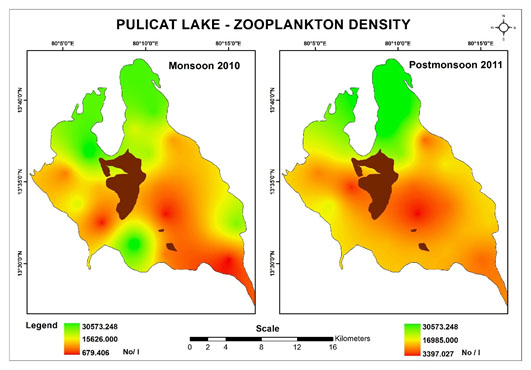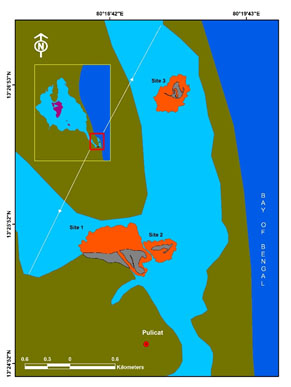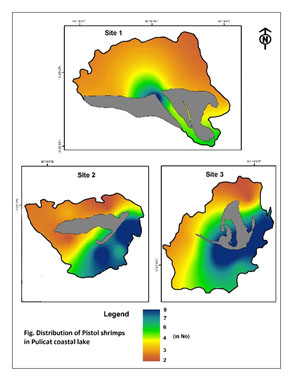Plankton diversity in Pulicat
 A total of 37 species of phytoplankton recorded during the present study in all twenty sampling points. Among them, 26 species were diatoms (Bacillariophyceae), 8 species were dinoflagellates (Dinophyceae), 2 species were blue greens (Cyanophycea) and 1 species were green algae. A total of 19 species of zooplankton recorded in all twenty sampling points under 7 major groups.The species, Chaetoceros compessus, Chaetoceros curvisetus, Coscinodiscus radiates, Coscinodiscus gigas, Nitzschia longissima, Planktoniella sol, Pleurosigma elongatum were occurred in twelve sampling points showed maximum spatial distribution and Navicula showed highest distribution in the Pulicat lake. The species of zooplankton, Favella sp, Acartia spinacuda, and Lucifer hanseni were noticed that they colonize and proliferate high numbers in Pulicat lake, where as the species, Globigerina sp, Sagitta elegans, Sagitta enflata, Pontella sp, macrosetella, microsetella, Oithona rigida were observed very meager in numbers. Station 1 and St. 2 were observed to have high proliferation of phytoplankton with the number of 13 and 12 species respectively. The density of phytoplankton varied from 1,01,910.828 to 5,94,479.8301 no/l in monsoon and 67940.55202 to 628450.1062 no/l in Postmonsoon season. The density of zooplankton varied from 3397.027 to 30573.248 (monsoon) and 679.4055 to 30573.248(Post monsoon) no/l. Among in different seasons, maximum species diversity (2.91) was observed in monsoon little lower in postomnsoon season of phytoplankton. Maximum species diversity (2.83) was observed in monsoon little lower in postomnsoon season of zooplankton.The study area is subjected to moderate fluctuations in temperature (29 – 32 in monsoon and 30.1 to 32.1in post monsoon oC). 20ppt is the minimum salinity in monsoon and maximum of 30ppt
A total of 37 species of phytoplankton recorded during the present study in all twenty sampling points. Among them, 26 species were diatoms (Bacillariophyceae), 8 species were dinoflagellates (Dinophyceae), 2 species were blue greens (Cyanophycea) and 1 species were green algae. A total of 19 species of zooplankton recorded in all twenty sampling points under 7 major groups.The species, Chaetoceros compessus, Chaetoceros curvisetus, Coscinodiscus radiates, Coscinodiscus gigas, Nitzschia longissima, Planktoniella sol, Pleurosigma elongatum were occurred in twelve sampling points showed maximum spatial distribution and Navicula showed highest distribution in the Pulicat lake. The species of zooplankton, Favella sp, Acartia spinacuda, and Lucifer hanseni were noticed that they colonize and proliferate high numbers in Pulicat lake, where as the species, Globigerina sp, Sagitta elegans, Sagitta enflata, Pontella sp, macrosetella, microsetella, Oithona rigida were observed very meager in numbers. Station 1 and St. 2 were observed to have high proliferation of phytoplankton with the number of 13 and 12 species respectively. The density of phytoplankton varied from 1,01,910.828 to 5,94,479.8301 no/l in monsoon and 67940.55202 to 628450.1062 no/l in Postmonsoon season. The density of zooplankton varied from 3397.027 to 30573.248 (monsoon) and 679.4055 to 30573.248(Post monsoon) no/l. Among in different seasons, maximum species diversity (2.91) was observed in monsoon little lower in postomnsoon season of phytoplankton. Maximum species diversity (2.83) was observed in monsoon little lower in postomnsoon season of zooplankton.The study area is subjected to moderate fluctuations in temperature (29 – 32 in monsoon and 30.1 to 32.1in post monsoon oC). 20ppt is the minimum salinity in monsoon and maximum of 30ppt  where as 31 is the minimum salinity in post monsoon and 34 is the maximum. Higher pH was recorded in St. 7 (monsoon), St. 1,15 16 (post monsoon)and lower pH noticed in St.12,14,17 (monsoon) and St.12 (post monsoon) of the Pulicat lagoon. Dissolved oxygen in the present study varied from 1.3 (St.5) to 5.6 mg/l (Fig.20) in monsoon and 2.4 (St. 13 and 15) to 3.5 (St.8) mg/l in Post monsoon. High content of nitrate in St 20 (both monsoon and post monsoon) and low value in St 6,7 (monsoon) St.3 (post monsoon) were observed in all stations. High amount of nitrite was recorded as 9.466 (monsoon) (St.13) 2.43 (post monsoon) (St. 20) µg/l and low as 0.106 and 0.095 µg/l (St.2) in both monsoon and post monsoon). Phosphate varied from 0.019 (St. 6) to 01.108 (St.20) µg/l in monsoon and post monsoon fluctuated between 0.03 (St.8) to 2.43 (St.17) µg/l. Silicate varied from 0.80 (St. 20) µg/l to 7.45 (St.6) µg/l in monsoon and varied from 0.02 (St. 1) µg/l to 4 (St.12) µg/l in post monsoon. Further details, Pl contact us.
where as 31 is the minimum salinity in post monsoon and 34 is the maximum. Higher pH was recorded in St. 7 (monsoon), St. 1,15 16 (post monsoon)and lower pH noticed in St.12,14,17 (monsoon) and St.12 (post monsoon) of the Pulicat lagoon. Dissolved oxygen in the present study varied from 1.3 (St.5) to 5.6 mg/l (Fig.20) in monsoon and 2.4 (St. 13 and 15) to 3.5 (St.8) mg/l in Post monsoon. High content of nitrate in St 20 (both monsoon and post monsoon) and low value in St 6,7 (monsoon) St.3 (post monsoon) were observed in all stations. High amount of nitrite was recorded as 9.466 (monsoon) (St.13) 2.43 (post monsoon) (St. 20) µg/l and low as 0.106 and 0.095 µg/l (St.2) in both monsoon and post monsoon). Phosphate varied from 0.019 (St. 6) to 01.108 (St.20) µg/l in monsoon and post monsoon fluctuated between 0.03 (St.8) to 2.43 (St.17) µg/l. Silicate varied from 0.80 (St. 20) µg/l to 7.45 (St.6) µg/l in monsoon and varied from 0.02 (St. 1) µg/l to 4 (St.12) µg/l in post monsoon. Further details, Pl contact us.

 Nine species of brackish water lake inhabiting shrimps were identified from Pulicat. They are Penaeus indicus, Penaeus monodon, Penaeus semisulcatus, Penaeus merquiensis, Macrobrachium rosenbergii, Metapenaeus offinis, Metapenaeus dobsoni, Metapenaeus monoceros, Penaeus
Nine species of brackish water lake inhabiting shrimps were identified from Pulicat. They are Penaeus indicus, Penaeus monodon, Penaeus semisulcatus, Penaeus merquiensis, Macrobrachium rosenbergii, Metapenaeus offinis, Metapenaeus dobsoni, Metapenaeus monoceros, Penaeus latisulcatus. There are two pistol shrimps were identified in Pulicat. All have been inhabited in dead oyster shell. They are Alpheus malabaricus, Alpheus heterochelis. Density of pistol shrimps varied from 3 to 7 no/sq.m in station 1. Higher density was noticed in sampling site 4 whereas lower density was found in 2 and 6. The pistol shrimps were varied in number from 2 to 9 No /sq. meter. Higher density was noticed in sampling site 1 whereas lower density number encounted in Site 2 and site 8. The pistol shrimps were varied in number from 2 to 8 /sq. meter. Higher density was noticed in sampling site 10 whereas lower density number encounted in Site 9. Weight of the pistol shrimp in different stations was shown that maximum growth rate was noticed in station 2 and lesser in St 2 (site 8) and St 3 (site 9). Density and weight of the oysters were high correlation with each other in terms of spatial contribution. Weight of the oysters were varied from 380 to 1650 grams in three sampling stations. The oysters in lowest weight was observed in station 3 and in site 9 whereas highest weight of the oyster was noticed in station 2 and in site 1.The density of oyster was observed to be varied from 2 to 9 No/ sq. m. lesser number of oysters were found in station 1 in site1, station 2 in site 7 and station 3 in site 8. Variation of temperature, Salinity and pH from 30 to 33 OC, 31 to 35ppt and 7.5 to 8.2
latisulcatus. There are two pistol shrimps were identified in Pulicat. All have been inhabited in dead oyster shell. They are Alpheus malabaricus, Alpheus heterochelis. Density of pistol shrimps varied from 3 to 7 no/sq.m in station 1. Higher density was noticed in sampling site 4 whereas lower density was found in 2 and 6. The pistol shrimps were varied in number from 2 to 9 No /sq. meter. Higher density was noticed in sampling site 1 whereas lower density number encounted in Site 2 and site 8. The pistol shrimps were varied in number from 2 to 8 /sq. meter. Higher density was noticed in sampling site 10 whereas lower density number encounted in Site 9. Weight of the pistol shrimp in different stations was shown that maximum growth rate was noticed in station 2 and lesser in St 2 (site 8) and St 3 (site 9). Density and weight of the oysters were high correlation with each other in terms of spatial contribution. Weight of the oysters were varied from 380 to 1650 grams in three sampling stations. The oysters in lowest weight was observed in station 3 and in site 9 whereas highest weight of the oyster was noticed in station 2 and in site 1.The density of oyster was observed to be varied from 2 to 9 No/ sq. m. lesser number of oysters were found in station 1 in site1, station 2 in site 7 and station 3 in site 8. Variation of temperature, Salinity and pH from 30 to 33 OC, 31 to 35ppt and 7.5 to 8.2 ridley (Lepidochelys olivacea) and Hawksbill turtles are frequent visitors in the study area. More number of nesting sited in Karunkali village and found to be suitable habitat for nesting which also have vegetation such as Ipomea and Spinefex. Another Important reason is the absence of human settlement and light pollution. This site recommended for turtle hatchery establishment
ridley (Lepidochelys olivacea) and Hawksbill turtles are frequent visitors in the study area. More number of nesting sited in Karunkali village and found to be suitable habitat for nesting which also have vegetation such as Ipomea and Spinefex. Another Important reason is the absence of human settlement and light pollution. This site recommended for turtle hatchery establishment